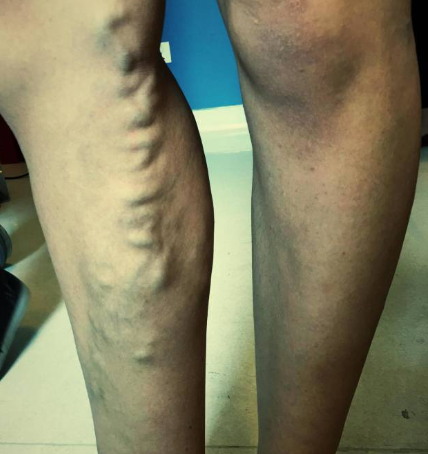
You’ve noticed them while changing clothes or after a warm shower: thick, ropy, bluish veins snaking their way across your thighs. They’re more prominent than the faint lines you’re used to seeing; they bulge and twist, looking less like part of your body and more like a topographic map laid over your skin. It’s a startling change, and it’s only natural to wonder what’s going on.
While often dismissed as a mere cosmetic issue, these bulging veins are a clear signal from your circulatory system. If the veins on your thighs are bulging like earthworms, it could mean the delicate plumbing in your legs is struggling against gravity, and the one-way valves designed to keep blood moving upward are beginning to fail.
This condition has a name: Varicose Veins. And understanding why it happens is the first step to managing it.
The Uphill Battle: A Lesson in Leg Plumbing
To appreciate what’s going wrong, you need to understand the monumental task your leg veins perform every day. Your arteries carry oxygen-rich blood down to your legs with the powerful push of your heartbeat. But your veins have the much harder job of carrying deoxygenated blood back up to your heart, fighting gravity every step of the way.
They manage this with two brilliant features:
- One-Way Valves: Tiny, delicate valves inside the veins open to let blood flow upward, then snap shut to prevent it from flowing backward.
- The Muscle Pump: When you walk, the muscles in your calves and thighs contract, squeezing the deep veins and pushing the blood upward.
When the System Breaks Down
Varicose veins form when those one-way valves become weak or damaged. Instead of snapping shut, they allow blood to leak backward and pool in the vein. The pressure from this pooled blood causes the vein to stretch, twist, and bulge—creating the “earthworm” effect on the surface of your skin.
What Your Body is Trying to Tell You
While genetics play a huge role (if your parents had them, you’re more likely to develop them), these bulging veins are often your body’s way of reporting on a few key issues:
- “We’re Sitting or Standing Too Much.” A sedentary lifestyle or a job that requires long periods on your feet is the biggest culprit. Without the regular contraction of the “muscle pump,” blood pools in the legs, putting constant pressure on the valves.
- “Hormonal Shifts Are Affecting Our Vessel Walls.” This is especially true for women. Pregnancy, menopause, and even hormone replacement therapy can relax vein walls, making the valves more prone to failure.
- “We’re Carrying Extra Weight.” Excess weight increases the pressure in the abdomen, which in turn puts more strain on the leg veins, making it harder for blood to return to the heart.
- “The Architecture of Our Tissues is Changing.” As we age, our skin naturally loses collagen and elasticity, becoming thinner. This makes already-bulging veins much more visible and pronounced.
Beyond Cosmetic: The Symptoms to Watch For
For many, varicose veins are primarily a cosmetic concern. But for others, they can cause very real symptoms, signaling that the venous insufficiency is becoming more significant. Watch for:
- An achy, heavy, or tired feeling in the legs, especially at the end of the day.
- Throbbing or cramping in the legs.
- Itching or a burning sensation around the vein.
- Worsened swelling in the feet and ankles.
- Skin changes like discoloration, inflammation, or even ulcers near the ankle.
What You Can Do
The goal is to improve circulation and support your hard-working veins.
- Get Moving: The simplest and most effective remedy. Walking, swimming, or cycling activates the “muscle pump” and keeps blood from pooling.
- Elevate Your Legs: When resting, try to elevate your legs above the level of your heart for 15-30 minutes, a few times a day.
- Consider Compression Stockings: These are not your grandmother’s support hose. Modern medical-grade compression stockings provide graduated pressure, strongest at the ankle and decreasing up the leg, which helps guide blood upward and supports the weakened valve walls.
- See a Vascular Specialist: If the veins are painful, or if you’re concerned about their appearance, a specialist can provide a proper diagnosis and discuss a range of modern treatments, from minimally invasive procedures like sclerotherapy (injections) and endovenous ablation (laser or radiofrequency) to more traditional surgery.
Those bulging veins on your thighs are a visible sign of an invisible struggle—the daily, heroic effort of your circulatory system. By seeing them as a signal and not just a flaw, you can take proactive steps to support your vein health, relieve discomfort, and keep the lifeblood flowing smoothly.